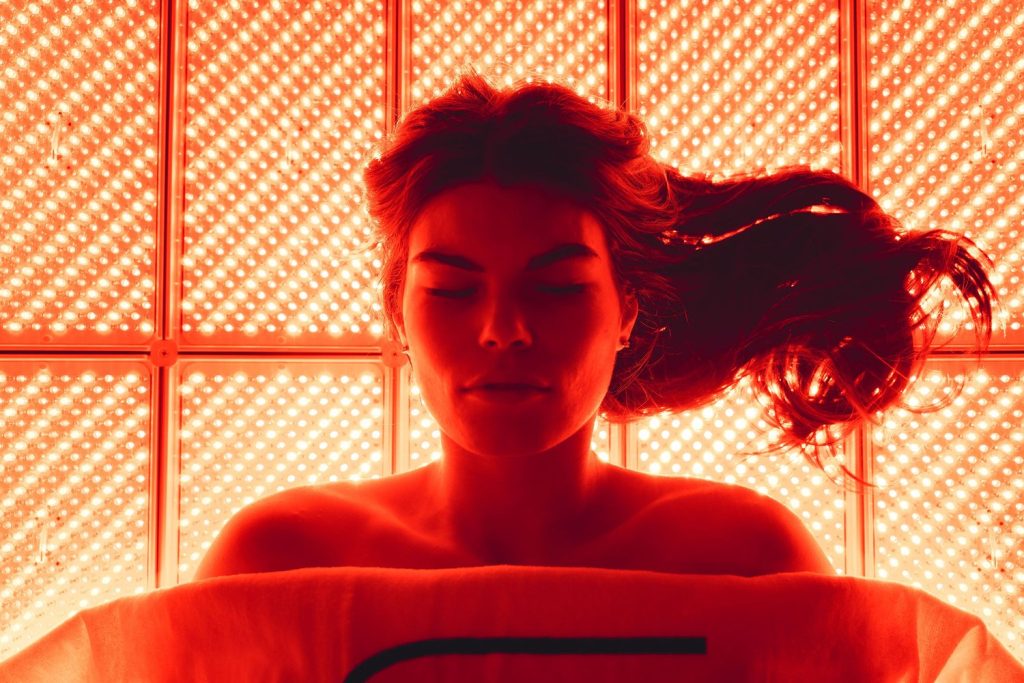Light therapy has been rising in popularity lately, and with good reason. Light therapy, especially red light therapy, has been proven repeatedly to have excellent health benefits, like pain relief, skin issues, anti-aging effects, etc. Most frequently, skin disorders are treated using red light treatment, which may achieve by influencing the blood flow to the skin.
So, does red light therapy increase blood flow in general? Many people struggle with slow circulation, leading to serious health issues. Maybe red light therapy could be just the thing to help this issue.
Read on for an in-depth look at how red light therapy influences circulation.

Does Red Light Therapy Increase Blood Flow?
Light therapy comes in a variation of many types of colors, each having potential health benefits relating to health problems.
However, red light therapy has been proven to be especially active when dealing with sleep deprivation, muscle inflammation, skin problems, and, you guessed it, slow blood flow.
The red light treatment involves using a device that emits red light, a lower wavelength of red, almost infrared, light through the skin. This stimulates cellar healing and rejuvenation by increasing the flow of oxygenated blood to the area.
The method may improve blood flow to specific body areas for various health-related issues. It’s generally used in medicine to help treat and maintain damaged tissue post-surgery or during medication.
Using this non-invasive method to increase blood flow in the human body may heal it on a cellular level, potentially leading to the healing of large-scale injuries and issues.
The Importance of Blood Flow
When discussing whether red light therapy increases blood flow, it’s essential to determine the importance of blood flow.
Blood flow is vital for your system to work correctly. Without good blood flow, slow blood circulation may cause a lack of oxygen reaching parts of the body equally. This can lead to sore muscles, blue or pale skin, weakness, blood clotting, numbness, and slow-healing wounds.
It might also lead to diseases of the heart and diabetes. We cannot stress the importance of healthy blood flow inside the body enough. Of course, many typical recommendations may be beneficial to help people suffering from this problem, like exercising more, a better diet, and stress-coping techniques.
While all of those are great ways to improve blood flow, red light therapy might be a more straightforward yet very effective method to improve blood flow. It has been proven to be potentially impactful in improving people’s blood flow.
What Are the Causes of Poor Circulation?
Poor circulation isn’t a medical condition. It’s a common side effect of many other medical conditions like obesity, diabetes, heart diseases, artery conditions, blood clots, and atherosclerosis. Smoking cigarettes and a sedentary lifestyle could also cause weakened circulation over a long period.
So, here’s a look at the most common reasons for poor circulation:
Diabetes
One of the many complications that accompany diabetes is poor circulation. Diabetes may lead to blood vessels in the feet and legs narrowing and becoming hard.
It may also cause other diseases like peripheral artery disease and atherosclerosis. People with diabetes also have a higher chance of amputation than those without diabetes, primarily because of problems with circulation.
Blood clots
Blood clotting is an essential and regular process that prevents excessive bleeding if a blood vessel in the body gets injured.
When the injury is completely healed, your body naturally dissolves the blood clot without any problems. But in some rare cases, clots can form on the inside of vessels even without an injury.
Situations like this may be potentially dangerous because abnormal clots that form inside a vein could restrict the blood returning to the heart, resulting in pain and swelling.
One of the severe conditions that may arise from this is deep vein thrombosis. It is a type of clot that forms in a major leg vein or, in some rare cases, in arms, pelvis, or other large veins in the body.
A clot in a vein may detach from the wall of the veins and travel through the heart to the lungs. Here it can become wedged and prevent adequate blood flow. This condition is called a pulmonary embolism, and it’s potentially dangerous.
Atherosclerosis
Atherosclerosis is a condition where fatty plaques form in the arteries, which makes the passage of blood become slower. These plaques are called atheromas and build up slowly inside people’s arteries.
In the early stages, arteries could compensate for the plaque buildup by widening themselves to keep regular blood flow. After a while, the artery can’t dilate any further, and the atherosclerotic plaque begins to narrow the arterial lumen.
Due to the restricted arterial blood flow, the delivery of blood in the body is generally lower. This can cause essential parts of the body to be deprived of oxygen and sorely needed nutrients. This might ruin your health in countless ways.

Sources: hellophysio.sg
Red Light Therapy and Blood Flow
By using red light therapy and focusing on a better diet, exercise, and an adequate sleeping routine, you may quickly see positive results in the body’s healing process, which will be sped up considerably. Red light activates cells, making them move by heating them, and it could bring increased oxygen to problematic areas of the body.
This happens because heat and lower wavelengths may affect the body on a cellular level, promoting faster healing. By using red light for short 10 to 15-minute sessions each day, you may do wonders for your body’s internal functions.
Remember that red light therapy isn’t some kind of magic solution to everything. It can be a good start, but a considerable lifestyle change could also be necessary for better health.
Red light therapy circulation benefits
As mentioned before, one of the best potential benefits of red light therapy is significantly increasing blood circulation following treatments. This means that tissues receive more oxygen and nutrients that promote healing.
This increase in circulation could lead to the body clearing itself of toxins more effectively. However, circulation that’s been improved with red light therapy may provide other benefits too, like:
Better sleep
Sleep is a vital part of staying healthy. Lack of sleep may cause plaque buildup in the arteries, while good sleep can ensure your blood is circulating correctly.
Sleep is directly connected to how well your circulatory system functions because when you sleep, it works overtime to bring as much oxygen as possible to every part of your body.
This is why sleep is a necessary part of recovery. So, by stimulating your circulation throughout the day using red light therapy, it functions even better during your sleeping hours. This could lead to you feeling more rested in the morning.
Less inflammation
Inflammation is the body’s natural reaction to being injured or infected, but sometimes inflammation can stick around too long, which may cause chronic health risks.
Nonetheless, by increasing circulation with red light therapy, you could potentially reduce inflammation considerably.
Recovery
A balanced and functioning circulatory system is also a key element for recovery. Oxygenated blood helps damaged muscle tissue to recover after damage or strain caused by an intense workout.
So, if you hit the gym often, red light therapy might help you recover more quickly and build more muscle.
Skin health
Better circulation is also a crucial part of fresh-looking skin. Active blood flow may give your skin a clear and rejuvenated look.
Your skin cells need lots of nutrients and oxygen to look their best. By making your circulation better, more vital nutrients reach your skin.
Using Red Light Therapy at Home
One of the tremendous benefits of using red light therapy is that many companies produce devices people can use at home.
If you suffer from decreased circulation in your feet and hands or acute or chronic pain in any part of your body, purchasing your red light therapy device might be wise.
Owning your therapy system can let you conveniently use it whenever you choose. The great thing about these devices is that a single one can be adjusted to fit any part of the body, so you may use it to possibly help heal multiple injuries.
General Red Light Therapy Advantages
Aside from potentially improving the functionality of your circulatory system, the benefits of using red light therapy may include the following:
- Non-invasive and painless.
- You can use it on any area of the body.
- An all-natural alternative to costly surgeries.
- Alternative to using painkillers.
- Simple yet effective treatment method.
- Easy to use at home.
- You can use it while sitting or lying at home watching TV.
- You can use it with other therapies like chiropractic, massage, PEMF, etc.
Conclusion
Does red light therapy increase blood flow? We may say yes. By using red light therapy, you can considerably increase the functionality of your circulatory system, which may lead to many health benefits. Additionally, it may help you avoid the many dangers accompanying slow circulation.
The red light therapy devices are straightforward to use. Conveniently a single device can be adjusted and used on different body parts.
So, if you’ve been interested in the potential of red light therapy for treating chronic problems or simply adding to a healthy lifestyle, you should invest in one of these devices. They may improve your health and your overall wellness.

Hello! I’m Nicky Rodgers.
Almost a decade ago, I got excited about the idea of employing alternative methods like red light therapy to create a healthier life.
To learn more about it, I did my Certified Light Therapist course from Photonic Therapy Institute and started looking into the intricacies of how light therapy influences several bodily processes. Before I knew it, my interest had become an obsession which resulted in this extensive blog.
Here, I offer countless well-researched articles to help you understand the benefits and uses of light therapy. I hope this information gives you a head start in your wellness journey.
